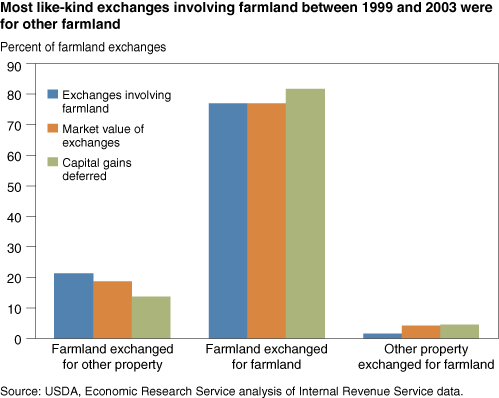Tax-Deferred Exchanges of Farmland Provide Valuable Savings to Some Farmers
- by James Williamson, Ron Durst and Mike Brady
- 9/1/2011
A tax-deferred exchange permits taxpayers to delay paying capital gains taxes on the disposition of property traded for 'like-kind' property. Known as '1031-exchanges' after the section of the Internal Revenue Code permitting their use, the exchanges offer landowners tax advantages over traditional land sales. By allowing farmland owners to defer payment of taxes on capital gains--which can be significant on land that has been owned for many years--farmers who sell land and use the proceeds to purchase other property can often increase their net worth, reduce borrowing costs, and expand the size of their operations (see chart under Resources and Environment on the Research Area Charts page).
However, concern has been raised, particularly among beginning farmers, that like-kind exchanges may be contributing to the rapid growth in farmland values because of the law's strict time limits for completing such exchanges. Under the law, a replacement property must be identified within 45 days of a land sale, and the exchange must be completed within 180 days, encouraging those involved in like-kind exchanges to outbid other potential buyers. Furthermore, since the definition of like-kind property is fairly broad, there is also concern among farmers and environmentalists that like-kind exchanges have encouraged residential and commercial developers to purchase more farmland than would have been possible without the associated tax benefits.
Using data from the Internal Revenue Service's (IRS) Sales of Capital Assets Panel Study, ERS researchers found that 1031-exchanges involving farmland represent a relatively small share of all tax-deferred exchanges--about 2 percent between 1999 and 2003. Exchanges involving farmland accounted for roughly 6 percent of all farmland dispositions (sales plus exchanges) reported to the IRS over the same period.
Despite their limited use, however, 1031-exchanges can be important for some farmland owners. Over a 5-year period, landowners making like-kind exchanges of farmland for farmland deferred $43,300, on average, in capital gains taxes. In essence, farmland-for-farmland exchanges can be thought of as 'rollover' investments. In contrast, landowners who sold farmland paid $5,200 in capital gains taxes, on average.
While ERS researchers found a great deal of year-to-year variability in the use of 1031-exchanges involving farmland, for the most part, farmland was exchanged for other farmland rather than for nonfarm property. In particular, relatively few exchanges involved other property (such as a shopping center) being exchanged for farmland, suggesting that like-kind exchanges were not used extensively by investors planning on converting farmland to nonfarm uses.
This article is drawn from:
- 'Tax-deferred exchanges of farmland: theory and evidence from federal tax data'. (2010). Agricultural Finance Review. Fall 2010, Vol. 70, No. 2, pp: 214-230. .


